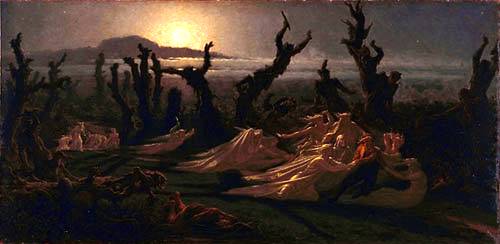 | ||
From Celtic mythology, Les Lavandières, also known as the kannerezed noz in Brittany, the Bean Nighe (in Scottish mythology), the lavandeiras (in Galician mythology), or the Midnight Washerwomen in English, are three old washerwomen. The three old women go to the water's edge at midnight to wash shrouds for those about to die according to the myth and folklore of Brittany; or to wash the bloodstained clothing of those who are about to die according to British folklore. The story of three old women may be due to the old Celtic tradition of the triple goddess of death and slaughter.
Contents
The washerwomen are small, dressed in green and have webbed feet. Their webbed feet may be the reason they are also sometimes called the cannard noz (meaning "night ducks") in Breton folklore.
France
In the nineteenth century, the belief in night washerwomen was very present in Brittany and Normandy, but it is also attested in many other regions of France: Berry, Pyrenees, Alps, Alsace, Morvan, Creuse, Burgundy and Ariège.
An important number of romantic french authors and poets wrote about the lavandières, from Guy de Maupassant and Victor Hugo to Georges Sand.
Brittany
In Brittany, legends of the lavandière de la nuit are attested by Jacques Cambry as early as the 18th century.}}
In Brittany, they can be an ominous portent, foretelling death, either one's own or a death in the family, though it is rare, just like they are not alway represented as old women, though they always have very pale skin, being creatures of the night, and are often dressed in white or in traditional clothing. They are very agile and strong physically, even when they do not look so.
The britton washerwomen wash graveclothes, usually at night, under the moonlight, and are notable for their intense dislike of being disturbed, cursing those who dare make so. They are know to ask passers-by for help in wringing clothes, breaking the arms of those who do so reluctantly and drow those who refuse. More rarely, they can also give charity.
According to the Breton legends, the washerwomen can either be ghosts whose name is known to all or else they are anonymous supernatural beings who appear in a human form. It is encountered during the year in the evening or in the middle of the night in known places (laundrette, creek), sometimes during the nights of full moon, sometimes only on the eve of the feast of the dead (All Saints' Day)
Numerous tales have been collected during the XIXe and XXe's, they are named in britton ar c’hannerezed-noz, ar c’houerezed-Noz or ar vaouez o welc’hin The late written tales we have of the Lavendières do not allow us to know with certitude if they have the same mythological origin as the bean nighe.
According to a Breton tradition, they are deceased who were buried in a dirty shroud:
Ireland
In Ireland, they are an ominous portent, foretelling death, either one's own or a death in the family. The washerwomen of Ireland wash the bloodied shirts of those about to die.
Scotland
In Scotland, if one can get between the washerwomen and the water, they are required to grant three wishes in exchange for three questions answered truthfully. There is also a tradition in Scotland of a single washer at the ford, the goddess Clotha, who gives the River Clyde its name.
Wales and Cornwall
In Wales and Cornwall a passerby must avoid being seen by the washerwomen. If they do get seen however, they are required to help wring out the sheets. If they twist the sheets in the same direction as the washerwomen, the individual's arms will be wrenched from their sockets and they will get pulled into the wet sheets and killed instantly. If, however, they twist in the opposite direction, the washerwomen are required to grant the person three wishes.
England
The washerwomen rarely appear in England, although lonely pools are often haunted by some supernatural creature, which may have derived from the same original root.
